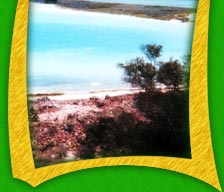|
WHAT’S IN A NAME?
In 1513, Spanish explorer Juan Ponce De Leon
discovered a small cluster of coral reef islands 70 miles from Key
West, just off Florida’s
gulf coast. Inspired by the abundance of sea turtles in the
area, De Leon christened the islands “Las Tortugas,” Spanish
for turtles. Soon thereafter, the word “dry” was
added to the name to alert mariners of the islands’ lack of
freshwater. Known today as the Dry Tortugas, only 40 acres of land
form this area’s seven major islands: Bush Key, East Key, Garden
Key, Hospital Key, Loggerhead Key, Long Key, and Middle Key.
SOOTY SEASON
Ponce
De Leon may have encountered hundreds of sea turtles upon his visits
to the Dry Tortugas, but it is the Sooty Tern that draws in bird-lovers
from around the world. Every year between March and September,
approximately 100,000 Sooty Terns descend upon Bush Key for nesting. Breeding
on islands along the equatorial zone, Sooties lay one to three eggs
in sandy depressions or in ground scrape. To protect nests and minimize
human interaction, Bush Key is closed to the public during nesting
season. However, with a pair of binoculars tourists can still
observe the rookery from Fort Jefferson. Visitors to these islands
can also witness several other species of sea birds such as Brown
Noddies, Masked Boobies, Brown Pelicans and the Magnificent Frigatebird.
A WORLD BELOW
Dry Tortugas National
Park is a keystone ecosystem, providing spawning and nursery habitats
for a variety of marine life. The island’s
coral reefs are the largest in North America and its crystal clear,
blue-green waters are home to more than 250 species of fish such
as Grouper, Nurse Sharks, Amberjack, Snook, Tarpon, Red Snapper
and the Atlantic
Bigeye. Visitors can also observe a stunning array of tropical
aquatic plants like Turtle Seagrass, Brain coral, sea fans and
sea sponges. Other animals, such as lobsters, stingrays, shrimp,
and sea stars add to the cornucopia of sea life in the Dry Tortugas,
making this park a snorkeler’s paradise.
Resources for this article
have been provided by Wikipedia and
the National
Park Service.
|











